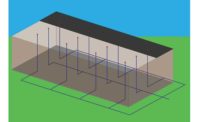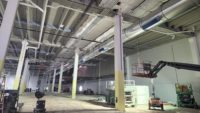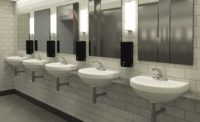Gravity often dictates storm drainage design. Pipe can only run so far with pitch before crossing over into livable space. At times, it requires a leader to drop down in the middle of the building, with the only solution being to excavate a long distance — still accounting for pitch — through the interior to reach the civils.
But what if you could completely eliminate excavation from the schedule? What if the pipe could run tight to the ceiling for a long run? What if the pipe diameter could be smaller while still providing the same flow rates?
Do I have your attention yet? Let me introduce you to siphonic roof drainage.
Recently, the Waldinger Corp. helped build a state-of-the-art manufacturing facility for Viega in McPherson, Kansas. Viega is building the 204,000-square-foot plant to expand production of its ProPress Copper product line and create a master distribution facility.
As a way to provide value engineering on the project, the Waldinger team looked at every option to help provide the best product, with the most efficient pricing possible to bring the best solution to the table. It enlisted Wichita, Kansas-based Professional Engineering Consultants (PEC) to help with the engineering on the project.
In the first round of designs, the Viega project needed three separate storm drainage lines, each containing seven gravity drains apiece, to appropriately discharge that amount of roof area. Additionally, they noticed the initial design called for the storm drainage to travel all the way to the exterior wall, causing the need for excavation inside of the building footprint on all three runs. This issue was caused by the limitations of a traditional gravity storm drainage system. Had the discharge pipe run all the way to the exterior wall, the piping itself would have limited the ceiling space, causing the piping to protrude and possibly become a forklift hazard.
Working with the MIFAB HydroMax design assist team, PEC was able to completely transform the initial design by creating a siphonic system fitting within its requirements. The biggest benefit in this scenario was the ability to route the discharge pipe to the engineer’s desired location. Whereas in the initial design, the leaders caused the need for excavation, in the HydroMax siphonic design, the pipework runs without pitch, enabling the storm drainage piping to run high and tight all the way to the west exterior wall of the building.
This ability to run the storm drainage to the exterior wall eliminated the need for excavation, and it reduced pipe-size diameters.
“With long runs, bridge cranes and equipment, the leaders needed to fit within the structure limits,” PEC’s Mechanical Project Manager Barry George says. “The siphoning drains system was the ideal solution.”
Reducing pipe diameter
How does siphonic drainage create a reduction in pipe size diameter? A traditional gravity system relies on air to push water through the system (2/3 air and 1/3 water). Siphonic drainage utilizes the entire pipework, filling it completely with water, which allows half the diameter pipe, on average, to be used in the same scenario.
Also adding to the cost savings associated with smaller diameter pipe are smaller diameter fittings, smaller hangers, smaller couplings and less strenuous labor to install. Additionally, because a siphonic drain is more efficient at discharging water (can run up to 26.2 ft/s compared to gravity’s 3 ft/s), PEC’s siphonic system for Viega was able to function with three runs each containing four drains, reducing the total number of drains from 21 to 12 for both the primary and overflow. Equally important, because a siphonic system runs completely flat, the systems were able to be installed parallel, giving the contractor the ability to prefab the threaded rod needed for the hangers.
As a result, the team was able to provide Viega with a more efficient system, while saving an enormous amount of money and labor. The Waldinger Corp. says on this particular project, it was able to see a 23% savings in material and labor.
As Viega continues to expand, siphonic systems have been used on a number of its buildings, most recently in its racking facility to enable space savings, thus providing even more storage space.





